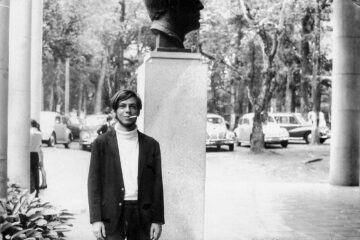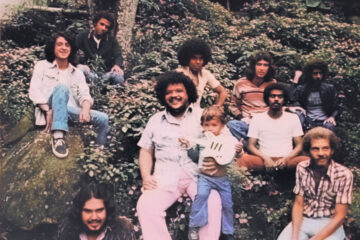From today’s point of view, sexy may just mean normal brashness. But looking at the cover of Gal Costa’s »Índia«, at least at the time, you could not help but think it a little risqué. And as the record was released in the middle of the Brazilian dictatorship, trouble immediately followed. The cover, which showed a tight-fitting indigenous loincloth in the centre of the picture, worn by the star herself, was censored and replaced with a plain blue cover.
Gal Costa, whose full name was Maria da Graça Costa Penna Burgos, was the grande dame of popular Brazilian music and one of the founders of tropicalismo. In 1964, at the age of just 18, she performed with Caetano Veloso, his sister Maria Bethânia and Gilberto Gil under the name, »Nós, por exemplo«. Tom Zé also joined them at some of their concerts. The concentrated innovation that came together there meant that all of them would go on to have a decisive influence on the country’s musical history.
Gal Costa began her solo career a year later. Those who had the chance to see Gal Costa – who died in November 2023 – at one of her last concerts in Berlin last July, got the impression from this retrospective of her work that she was by no means averse to even louder rock and fusion sounds than during the decades of her career.
Captivating Restraint
In contrast, there are no signs of stadium tropicalismo on »Índia«. The title track begins with soft guitar and string sounds, and after the first ten seconds you find it hard not to fall in love with the diminutive instrumental figure who opens the record. And no later than by the time the singing begins, ten seconds later, there are no limits to the rapture. Gal Costa sings in the hushed and reserved intonation that was almost obligatory for Brazilian singers at the time. This does not hold it back in its expression, but rather gives it just the right shape. Only when Costa moves into the higher registers in the chorus, which her vocal range easily allows, does she increase the volume a little.
Gal Costa’s vocals remain so controlled that you might miss her performance if you are just casually listening.
The orchestra also intensifies with each new chorus over the course of the nearly seven-minute track, building to a powerful yet discreetly lush finale. Costa’s vocals and Rogério Duprat’s orchestral arrangement make for a congenial combination. And this opening is indeed the most pompous moment on the whole album.
The fact that the record was fabulously cast comes across even more discreetly on the second track, »Milho Verde«. The rhythmically complex »Portuguese folklore«, as the title suggests, was arranged by Gilberto Gil, who not only played the guitar but also took over the musical direction of the album. They are joined by bassist Luiz Alves and percussionists Chico Batera and Paulo Pereira D’Aquino, a.k.a. Chacal, who turn this chamber music number into a model of restraint.
Seduced – not overwhelmed
To add another big name: Arthur Verocai for his part arranged two of the numbers. Both »Presente Cotidiano« and »Pontos de Luz« turned out to be fleeting in a concentrated manner, the former with strings consistently held in the background and other selectively employed instruments, such as the electric organ, the latter with sovereign, no-fuss fusion. At no point does Verocai’s funk provoke Gal Costa into any kind of outburst.
Gal Costa’s vocals remain so controlled throughout all of this that you might miss her performance if you are just casually listening. And yet it is clearly she who combines the exquisite material and the musical efforts of her colleagues to create an album whose greatness lies not in being unreservedly overwhelming, but in seducing the listener with elegance, complexity and sophistication. If you need final proof, listen to the closing track »Desafinado«, one of Antonio Carlos Jobim’s greatest hits par excellence. João Gilberto couldn’t have done it any better himself.










